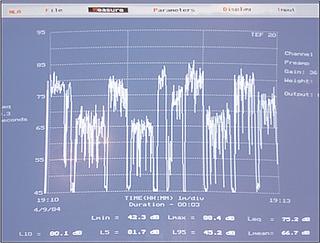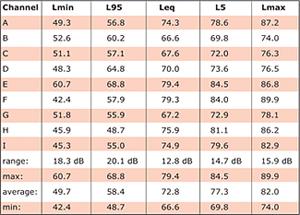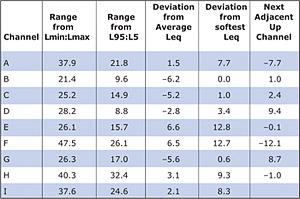Nine Channels on the Level

Last month I discussed the relative audio levels of commercials and programs, and even presented some measurements pertaining to each of those genres. Further, I promised to take another look at channel-to-channel levels for this month. I wanted to do this before our industry abandons analog forever, and I plan to take another set of measurements after we've changed over, to see if the blessed event has helped us in our production efforts.
WHAT I MEASURED
I set up my Noise Level Analysis software to measure C-weighted acoustic sound pressure levels at the preferred listening position and then made two sets of measurements.

Fig. 1: A screen shot of a three-minute history of the relative levels (dB SPL, C-weighted) of nine adjacent television channels (as provided by DirecTV). Each channel is present for about 20 seconds.First, I took a histogram (level over time) of three minutes of fixed but uncalibrated television playback (all speakers on, at a reference level where one speaker playing pink noise at -14 dBFS yields 85 dBC SPL), while I switched sequentially between the nine lowest channels in the DirecTV bundle (a grab bag of commercial and public networks, some HD) every 20 seconds. This was during a late weekday afternoon period, with soaps, reality TV, news-mag and related programming. I made no distinction between commercial and program segments. I took a photo of the histogram and related data (see Fig. 1).
Second, I took nine 1-minute NLAs, one for each of the channels in question—in the same order—and pulled together that data in a table (Table 1) and then some derived information (Table 2).
Please note that the data in the tables does not exactly agree with the data displayed in Fig. 1. That is because these were taken at somewhat different points in time (approximately a half-hour later), with different material happening. Note also that the measured level differences are large enough that those variances are pretty much irrelevant.

Table 1 shows Lmin, L95, Leq, L5 and Lmax for each of the nine channels A through I. Below that data is the range among all channels in each category, and the maximum, average and minimum levels in each category among the channels. All channel levels in dBC SPL, range in dB.What I found is entirely too obvious: channel-to-channel levels vary a lot, to a point that is definitely annoying and far worse than the differences between program and commercial levels, (see Table 1).
WHAT I FOUND
The two most important levels to study here are Leq (the power-based average level of the entire segment) and Lmax (the peak level measured during the segment). Channel E has the loudest Leq (79.4 dBC SPL) while Channel B has the softest (66.6 dBC SPL). That's a level difference between channels E and B of almost 13 dB. Yikes!
Lmax variance is worse: Channel F is loudest (at 89.9 dBC SPL), while Channel B is softest (74 dBC SPL), a difference of almost 16 dB.
At the same time, there was nothing (in my opinion) in the various program segments (all basically talking heads, with some music beds, no action sequences) to justify these differences. Further, please note that the histogram (Fig. 1) was taken about half an hour earlier than the NLAs, with different programs, and Channels E and F are still among the loudest, while Channel B is one of the softest, suggesting that these channel level differences appear to be reasonably stable over time, (see Table 2).
Table 2 shows a variety of data derived from the raw data.
- • Range from Lmin:Lmax show the total technical dynamic range from loudest combined surround signal(s) to the lowest signal or room noise floor, whichever is louder. Channel F had the widest range, at 47.5 dB, while Channel B had the narrowest, at 21.4 dB.
- • Range from L95:L5 shows what I think of as the meaningful signal dynamic range, ignoring outliers and the room noise floor. Channel H had the widest range at 32.4 dB while Channel B (again) had the narrowest at 9.6 dB.
- • The average of all the Leqs is 72.8 dBC SPL, and the deviation from average Leq is shown for each channel.
- • The softest channel was Channel B, with an Leq of 66.6 dBC SPL, and the column showing Deviation from Softest Leq shows each channel's deviation from that end of the range.
- • Next Adjacent Channel Up shows the level change you would encounter when changing from Channel A to B, etc. The nasty ones are A-to-B with a drop of almost 8 dB, D-to-E with a boost of over 9 dB, F-to-G with a drop of more than 12 dB, and G-to-H with a boost of about 9 dB.
This is to say that essentially half of the channel surfing changes I measured involved unacceptable level shifts.

Table 2 shows a variety of derived values for each channel. All levels are in dB.WHAT IT BOILS DOWN TO
This is about as "real world" as it gets, with a little instrumentation added. The signal sources are about as typical of the end user experience as we can get. The levels are reasonable (with 72.8 dBC SPL as an average Leq), particularly for a largish screening room like mine. Lmin:Lmax ranges are pretty substantial, while L95:L5 ranges vary a lot (9.6 dB on Channel B suggests substantial compression). The dialogue levels on Channels E, F and H were irritatingly loud to my ears.
It is fair to say that a competent levels mixer could easily reduce the variance of Leq for the nine channels to less than 3 dB, an improvement of almost 10 dB. Unfortunately, the corollary to this is that the audio levels management now being done (by DirecTV, by the networks, by other cable and satellite operators?) may be way less than competent.
There is no rocket science here. The variation in levels is both easily audible and easily managed. At the same time, the relationship between Leq and Lmax (the headroom) is pretty consistent among channels, so that if we get Leqs under control, Lmax will stabilize as well.
In the meantime, we aren't there yet.
Thanks for listening.
Dave Moulton is waiting and waiting and waiting for the analog-to-digital changeover. You can complain to him about anything at his Web site,www.moultonlabs.com.
Get the TV Tech Newsletter
The professional video industry's #1 source for news, trends and product and tech information. Sign up below.












